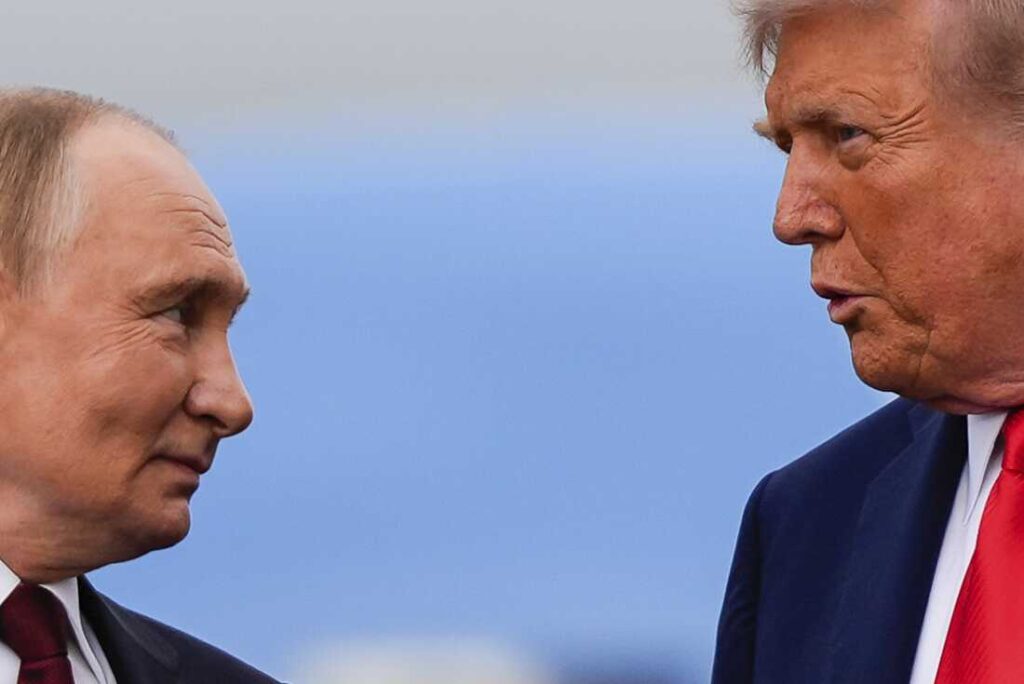The complex diplomatic landscape between Russia and America has entered a critical phase, characterized by high-stakes negotiations over the war in Ukraine, aggressive tariff policies, and evolving bilateral relations. As these two superpowers attempt to find common ground while managing global economic pressures, the implications extend far beyond their borders, affecting international trade relationships and regional stability worldwide.

Recent Summit Developments: Alaska 2025
The historic August 15, 2025, summit in Anchorage, Alaska marked the first meeting between US President Donald Trump and Russian President Vladimir Putin since the full-scale invasion of Ukraine began in 2022. This unprecedented gathering on US military property represented Putin’s first visit to a Western nation since 2022 and his first trip to the United States since 2015.
Despite the high expectations, the summit concluded without concrete agreements on a Ukraine ceasefire. However, both leaders described the talks as productive, with Trump rating them “10 out of 10”. The meeting established a framework for future negotiations, with Trump subsequently hosting Ukrainian President Volodymyr Zelenskyy and European leaders in Washington to continue peace discussions.
The diplomatic process revealed significant challenges. While Trump appeared open to territorial concessions from Ukraine, including ceding Crimea and abandoning NATO membership aspirations, Zelenskyy maintained that Ukraine’s constitution prohibits relinquishing territory. Putin’s demands remained extensive, seeking not only territorial gains but also broader security restructuring in Europe.
Tariff Wars and Economic Pressure
Secondary Sanctions Strategy
Trump’s administration has implemented a controversial “secondary tariffs” strategy, targeting countries that continue purchasing Russian oil as a means to pressure Moscow into peace negotiations. This approach has created significant tensions with key allies and trading partners, particularly India.
The tariff policy operates on multiple levels. The United States has imposed an additional 25% tariff on India, bringing total tariffs on Indian goods to 50%. This represents one of the highest tariff rates imposed by the US on any major trading partner. The administration has warned that these measures could escalate to 100% tariffs or even 500% under proposed congressional legislation.
Selective Enforcement and Double Standards
The differential treatment of countries purchasing Russian oil has raised questions about the consistency of US policy. While India faces severe penalties, China—the largest importer of Russian oil at approximately 109 million Tonnes in 2024 compared to India’s 88 million Tonnes—has largely escaped similar sanctions.
US Secretary of State Marco Rubio defended this approach, explaining that sanctioning Chinese refineries would disrupt global oil markets and drive-up energy prices worldwide. European nations have reportedly expressed concerns about broader sanctions that could affect their own energy security.
Paradoxically, Putin revealed during the Alaska summit that US-Russia bilateral trade had actually grown by 20% since Trump took office, highlighting contradictions in the administration’s approach. This revelation came as the US simultaneously punished other nations for maintaining trade relationships with Russia.
Strategic Implications and Future Scenarios
Economic Warfare Effectiveness
The secondary tariff strategy represents a significant shift in how economic pressure is applied in international conflicts. By targeting third countries rather than direct adversaries, the United States aims to create a network effect that isolates Russia economically. However, this approach faces several challenges:
Russia has developed sophisticated sanctions-evasion mechanisms, including a “shadow fleet” of tankers and alternative financial systems, which could help trading partners circumvent US penalties. The establishment of what Russia calls “special mechanisms” with countries like India suggests that economic partnerships can be restructured to withstand external pressure.
Global Market Disruption
The tariff wars have broader implications for global energy markets and trade relationships. If successful, these measures could reduce Russian oil and gas flows to international markets, potentially driving up global energy prices and affecting worldwide economic stability. The policy creates a complex web of economic interdependencies that could reshape international trade patterns.
Alliance Restructuring
Trump’s tariff policy is fundamentally altering traditional alliance structures. Long-standing partnerships with countries like India are being strained over energy policy differences, while relationships with traditional adversaries show unexpected flexibility. This realignment suggests that economic interests may increasingly override traditional geopolitical alignments.
Future Possibilities and Scenarios
Diplomatic Breakthrough Potential
Despite current tensions, several factors suggest that meaningful progress toward peace in Ukraine remains possible. The February 2025 Riyadh summit between US and Russian delegates laid groundwork for high-level negotiations. Trump’s willingness to engage directly with Putin, combined with Russia’s apparent openness to dialogue, creates opportunities for diplomatic breakthroughs.
However, fundamental disagreements persist. Russia seeks extensive territorial concessions and security guarantees that would effectively reshape Europe’s security architecture. Ukraine and its European allies reject proposals that would legitimize territorial conquest through force. Any sustainable agreement will require compromises that both sides currently find unacceptable.
Economic Integration Scenarios
Looking ahead, several economic scenarios could emerge:
Gradual Normalization: If peace negotiations succeed, the extensive sanctions regime could be gradually unwound, allowing for renewed economic cooperation between Russia and the West. Putin’s comments about potential areas for cooperation—including trade, technology, and space exploration—suggest Russian interest in broader engagement.
Bifurcated Global Economy: Continued tensions could lead to the formation of separate economic blocs, with Russia, China, and other non-Western countries developing parallel financial and trade systems that operate independently of US-dominated structures.
Selective Re-engagement: A more likely scenario involves partial normalization in specific sectors while maintaining broader restrictions, allowing for pragmatic cooperation in areas of mutual interest while preserving leverage in others.
Regional and Global Impacts
The outcome of US-Russia negotiations will significantly influence global dynamics:
Energy Markets: Resolution of the Ukraine conflict could stabilize global energy prices and supply chains, benefiting consumers worldwide. Continued conflict would likely maintain volatility in energy markets.
Alliance Systems: Success in achieving a negotiated settlement could strengthen Trump’s position domestically and internationally, potentially influencing other conflicts. Failure could weaken US credibility and encourage alternative diplomatic frameworks.
Economic Order: The use of secondary tariffs as a diplomatic tool is setting precedents that other nations may adopt, potentially fragmenting the global economy along political lines.
Challenges and Uncertainties
Several factors complicate predictions about future US-Russia relations:
Domestic Politics: Both leaders face domestic political pressures that limit their flexibility in negotiations. Trump must balance his desire for diplomatic success with pressure from Congress and traditional foreign policy establishments. Putin faces the challenge of justifying any territorial concessions to a domestic audience that has been told the conflict is existential.
European Position: European allies remain skeptical of agreements that legitimize Russian territorial gains, complicating any potential settlement. Their cooperation will be essential for implementing and enforcing any peace agreement.
Ukrainian Agency: Ukraine’s position as a sovereign nation fighting for its territorial integrity means that sustainable peace cannot be imposed without Kyiv’s genuine agreement. Zelenskyy’s constitutional and political constraints limit his ability to make territorial concessions.
The Future of America-Russia Relations: Opportunities and Risks
While confrontations remain intense, the interaction between the two nations also holds prospects for evolution towards cautious co-existence or cooperation in certain domains.
Areas for Potential Collaboration
- Energy Negotiations: Discussions to stabilize energy markets could serve as confidence-building measures.
- Arms Control Agreements: Reviving or renegotiating arms control treaties may reduce nuclear risks.
- Counterterrorism and Cybersecurity: Shared interests in combating global terrorism and cyber threats may provide cooperative avenues.
- Space Exploration and Technology: Joint scientific ventures could transcend political animosities.
Enduring Challenges
- Mistrust and Propaganda: Decades of Cold War legacies and recent adversarial rhetoric fuel mutual suspicion.
- Domestic Political Pressures: Leaders face internal constraints limiting their negotiation leverage.
- Differing Worldviews: Competing visions for global order and influence complicate alignmen
The Tariff and Trade War: Economic Leverage and Global Realignments
The US’s targeted tariffs on countries trading with Russia—particularly the harsh penalties on India—have caused significant geopolitical ripple effects. The move reflects a broader US strategy to leverage economic tools beyond sanctions on Russia itself to influence global behavior.
Impact on India and Regional Responses
India has maintained robust trade relations with Russia, particularly in oil imports, accounting for about 88 million tonnes annually. In response to US tariffs, Russia has offered India strategic discounts and special mechanisms to sustain their energy partnership.
India’s stance underscores a growing trend among emerging economies seeking to balance ties with multiple global powers rather than aligning exclusively with the West. This pragmatism complicates the US’s ability to enforce a strict economic isolation of Russia.
Broader Geopolitical Implications
The selective tariff imposition accentuates the emerging multipolar world order, where economic interests are increasingly diversified. China’s exemption from similar US sanctions, despite being Russia’s largest oil customer, reflects the US’s acknowledgment of China’s critical role in global energy markets and its economic heft.
This scenario underlines risks of fragmentation in global trade systems, with countries potentially forming competing blocs based on geopolitical alliances rather than shared economic principles. Such divisions could undermine international cooperation on broader issues like climate change, security, and trade regulation
Conclusion
The current phase of US-Russia relations represents a critical juncture in international affairs. While the Alaska summit demonstrated both leaders’ willingness to engage in substantive dialogue, fundamental disagreements about territorial integrity, security arrangements, and international law remain unresolved.
The innovative use of secondary tariffs as a diplomatic tool has created new dynamics in international relations, but their effectiveness remains unclear. The differential treatment of various countries has exposed tensions within existing alliance structures and may accelerate the development of alternative international systems.
The path forward requires careful balancing of competing interests and creative diplomatic solutions. Success would not only end the devastating conflict in Ukraine but also establish new frameworks for great power cooperation in an increasingly multipolar world. Failure could entrench divisions that persist for decades, fundamentally altering the global order in ways that may prove difficult to reverse.
The stakes extend far beyond the immediate participants, affecting global energy security, international law, and the broader question of whether diplomatic engagement can still resolve fundamental conflicts between major powers in the 21st century. As negotiations continue, the world watches to see whether pragmatic interests can overcome ideological differences and historical grievances to forge a sustainable peace.
